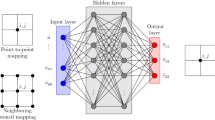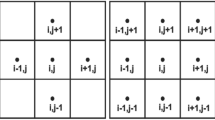Abstract
Recently, the methodology of deep learning is used to improve the calculation accuracy of the Reynolds-averaged Navier-Stokes (RANS) model. In this paper, a neural network is designed to predict the Reynolds stress of a channel flow of different Reynolds numbers. The rationality and the high efficiency of the neural network is validated by comparing with the results of the direct numerical simulation (DNS), the large eddy simulation (LES), and the deep neural network (DNN) of other studies. To further enhance the prediction accuracy, three methods are developed by using several algorithms and simplified models in the neural network. In the method 1, the regularization is introduced and it is found that the oscillation and the overfitting of the results are effectively prevented. In the method 2, y+ is embedded in the input variable while the combination of the invariants is simplified in the method 3. From the predicted results, it can be seen that by using the first two methods, the errors are reduced. Moreover, the method 3 shows considerable advantages in the DNS trend and the smoothness of a curve. Consequently, it is concluded that the DNNs can predict effectively the anisotropic Reynolds stress and is a promising technique of the computational fluid dynamics.
Similar content being viewed by others
References
Vandriest E. R. On turbulent flow near a wall [J]. Journal of the Aeronautical Sciences, 1956, 23(11): 1007–1011.
Feiereisen W. J. Numerical simulation of a compressible homogeneous, turbulent shear flow [D]. Doctoral Thesis, Stanford, USA: Stanford University, 1981.
Benzi R., Patarnello S., Santangelo P. On the statistical properties of two-dimensional decaying turbulence [J]. Europhysics Letters, 1987, 3(7): 811–818.
Brachet M. E., Meneguzzi M., Sulem P. L. Small-scale dynamics of high-reynolds-number two-dimensional turbulence [J]. Physical Review Letters, 1986, 57(6): 683–686.
Gilbert A. D. Spiral structures and spectra in two-dimensional turbulence [J]. Journal of Fluid Mechanics, 1988, 193: 475–497.
Pope S. B. Turbulent flows [M]. Cambridge, UK: Cambridge University Press, 2001.
Rodi W. On the simulation of turbulent flow past bluff bodies [J]. Journal of Wind Engineering and Industrial Aerodynamics, 1993, 46-47: 3–19.
Speziale C. G. A review of Reynolds stress models for turbulent shear flows [C]. 20th Symposium on Naval Hydrodynamics, Washington DC, USA, 1995.
Spalart P. R. Philosophies and fallacies in turbulence modeling [J]. Progress in Aerospace Sciences, 2015, 74: 1–15.
Dutta R., Xing T. Five-equation and robust three-equation method for solution verification of large eddy simulations [J]. Journal of Hydrodynamics, 2018, 30(1): 23–33.
Cheng H. Y., Long X. P., Liang Y. Z. et al. URANS simulations of the tip-leakage cavitating flow with verification and validation procedures [J]. Journal of Hydrodynamics, 2018, 30(3): 531–534.
Wang C. C., Huang B., Wang G. Y. et al. Numerical simulation of transient turbulent cavitating flows with special emphasis on shock wave dynamics considering the water/vapor compressibility [J]. Journal of Hydrodynamics, 2018, 30(4): 573–591.
Hinton G., Salakhutdinov R. Reducing the dimensionality of data with neural networks [J]. Science, 2006, 313(5786): 504–507.
Tracey B., Duraisamy K., Alonso J. Application of supervised learning to quantify uncertainties in turbulence and combustion modeling [C]. 51st AIAA Aerospace Sciences Meeting Including the New Horizons Forum and Aerospace Exposition, Texas, USA, 2013, 2013–0259.
Ling J., Ruiz A., Lacaze G. et al. Uncertainty analysis and data-driven model advances for a jet-in-crossflow [J]. Journal of Turbomachinery, 2016, 139(2): 021008.
Ling J., Kurzawski A., Templeton J. Reynolds averaged turbulence modelling using deep neural networks with embedded invariance [J]. Journal of Fluid Mechanics, 2016, 807: 155–166.
Kutz J. N. Deep earning in fluid dynamics [J]. Journal of Fluid Mechanics, 2017, 814: 1–4.
Wang J. X., Wu J. L., Xiao H. Physics-informed machine learning approach for reconstructing Reynolds stress modeling discrepancies based on DNS data [J]. Physical Review Fluids, 2017, 2(3): 1–22.
Xiao H., Wu J. L., Wang J. X. et al. Quantifying and reducing model-form uncertainties in Reynolds-averaged Navier-Stokes simulations: A data-driven, physics-informed Bayesian approach [J]. Journal of Computational Physics, 2016, 324(C): 115–136.
Lecun Y., Bengio Y., Hinton G. Deep learning [J]. Nature, 2015, 521(7553): 436.
Jarrett K., Kavukcuoglu K., Ranzato M. et al. What is the best multi-stage architecture for object recognition? [C]. International Conference on Computer Vision (ICCV), Kyoto, Japan, 2009, 2146–2153.
Krizhevsky A., Sutskever I., Hinton G. E. ImageNet classification with deep convolutional neural networks [C]. 25th International Conference on Neural Information Processing Systems, Nevada, USA, 2012, 1097–1105.
He K., Zhang X., Ren S. et al. Deep residual learning for image recognition [C]. International Conference on Computer Vision (ICCV), Santiago, Chile, 2015, 1026–1034.
Maas A. L., Hannun A. Y., Ng A. Y. Rectifier nonlinearities improve neural network acoustic models [C]. International Conference on Machine Learning (ICML), Atlanta, USA, 2013.
Pope S. B. A more general effective-viscosity hypothesis [J]. Journal of Fluid Mechanics Digital Archive, 1975, 72(2): 331–340.
Jones R., Templeton J., Ling J. Machine learning strategies for systems with invariance properties [J]. Journal of Computational Physics, 2016, 318(8): 22–35.
Moser R. D., Kim J., Mansour N. N. Direct numerical simulation of turbulent channel flow up to Re = 590 ? [J]. Physics of Fluids, 1999, 11(4): 943–945.
Krogh A., Hertz J. A. A simple weight decay can improve generalization [C]. International Conference on Neural Information Processing Systems. San Mateo, California, USA, 1992, 950–957.
Author information
Authors and Affiliations
Corresponding author
Additional information
Project supported by the National Key R&D Program (Grant No. 2016YFC0301601).
Rights and permissions
About this article
Cite this article
Zhang, Z., Song, Xd., Ye, Sr. et al. Application of deep learning method to Reynolds stress models of channel flow based on reduced-order modeling of DNS data. J Hydrodyn 31, 58–65 (2019). https://doi.org/10.1007/s42241-018-0156-9
Received:
Revised:
Accepted:
Published:
Issue Date:
DOI: https://doi.org/10.1007/s42241-018-0156-9




